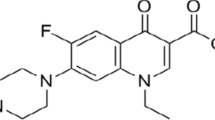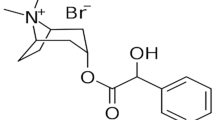Abstract
A theoretical study on the interaction of the ractopamine (RAC) with functional monomers in the formation of imprinted polymers was investigated by means of quantum chemical calculations. In the present work, all structural optimization, interaction energies calculations and solvent effects were performed using density functional theory (DFT) method. The obtained data from five systems were used to evaluate the ability to form non-covalently bonded monomer–template complexes under vacuum and the different solvents conditions. These systems were presented by the following monomers: acrylic acid (AA), methacrylic acid (MAA), trifluoromethylacrylic acid (TFMAA), acrylamide (AAm) and methylacrylamide (MAAm). The solvent effects of pre-polymerization were considered using the solvation model based on density (SMD) in five solvents (toluene, chloroform, methanol, acetonitrile and dimethyl sulphoxide (DMSO) in this work. The results were evaluated through the solvation energy and the reaction energetics. Computer simulation of the interaction between the ractopamine and functional monomers indicated that although TFMAA has a strong interaction with the template in comparison to other complex forms in gas phase; it possesses non-specific interaction with the ractopamine molecule in solution. Moreover, MAAm was suitable for imprinting ractopamine, because the strongest interaction occurred between ractopamine and MAAm with a polymerization ratio of 1:4 in DMSO. The values of ΔG and ΔE were 26.30 and 40.51 kcal mol−1, respectively. This work may be useful for providing information for the choice of suitable functional monomer and proper solvent in the preparation of RAC molecularly imprinted polymers.






Similar content being viewed by others
References
Li TF, Yao T, Zhang C, Liu GY, She YX, Jin MJ, Jin F, Wang SS, Shao H, Wang J (2016) Electrochemical detection of ractopamine based on a molecularly imprinted poly-o-phenylenediamine/gold nanoparticle–ionic liquid–graphene film modified glass carbon electrode. RSC Adv 6:66949–66956
Yang F, Wang PL, Wang RG, Zhou Y, Su XO, He YJ, Shi L, Yao DS (2015) Label free electrochemical aptasensor for ultrasensitive detection of ractopamine. Biosens Bioelectron 77:347–352
MOA Regulation 176, Ministry of Agriculture, P.R. China. 2002
Commission decision, 1996/23/EC. Off J Eur Commun L125:10
Shishani E, Chai SC, Jamokha S, Aznar G, Hoffman MK (2003) Determination of ractopamine in animal tissues by liquid chromatography-fluorescence and liquid chromatography/tandem mass spectrometry. Anal Chim Acta 483:137–145
Zhang LY, Chang BY, Dong T, He PL, Yang WJ, Wang ZY (2009) Simultaneous determination of salbutamol, ractopamine, and clenbuterol in animal feeds by SPE and LC–MS. J Chromatogr Sci 47:324–328
Wang L, Li YQ, Zhou YK, Yang Y (2010) Determination of four β2-agonists in meat, liver and kidney by GC–MS with dual internal standards. Chromatographia 71:737–739
Vulić A, Pleadin J, Perši N, Milić D, Radeck W (2012) UPLC–MS/MS determination of ractopamine residues in retinal tissue of treated food-producing pigs. J Chromatogr B 895–896:102–107
Tang C, Zhang J, Li L, Zhao Q, Bu D (2014) Ractopamine residues in urine, plasma and hair of cattle during and after treatment. J Anal Toxicol 38:149–154
Zhang Y, Wang FX, Fang L, Wang S, Fang GZ (2009) Rapid determination of ractopamine residues in edible animal products by enzyme-linked immunosorbent assay: development and investigation of matrix effects. J Biomed Biotechnol 12:269–281
Wang WY, Zhang YL, Wang JY, Shi X, Ye JN (2010) Determination of β-agonists in pig feed, pig urine and pig liver using capillary electrophoresis with electrochemical detection. Meat Sci 85:302–305
Yang X, Feng B, Yang P, Ding YL, Chen Y, Fei JJ (2014) Electrochemical determination of toxic ractopamine at an ordered mesoporous carbon modified electrode. Food Chem 145:619–624
Chen D, Yang M, Zheng NJ, Xie N, Liu DL, Xie CF, Yao DS (2016) A novel aptasensor for electrochemical detection of ractopamine, clenbuterol, salbutamol, phenylethanolamine and procaterol. Biosens Bioelectron 80:525–531
Figueiredo L, Erny GL, Santos L, Alves A (2016) Applications of molecularly imprinted polymers to the analysis and removal of personal care products: a review. Talanta 146:754–765
Chen L, Wang X, Lu W, Wu X, Li J (2016) Molecular imprinting: perspectives and applications. Chem Soc Rev 45:2137–2211
Zhong SA, Kong YY, Zhou L, Zhou CY, Zhang XN, Wang Y (2014) Efficient conversion of myricetin from Ampelopsis grossedentata extracts and its purification by MIP–SPE. J Chromatogr B 945–946:39–45
Jiang TH, Zhao LX, Chu BL, Feng QZ, Yan W, Lin JM (2009) Molecularly imprinted solid-phase extraction for the selective determination of 17β-estradiol in fishery samples with high performance liquid chromatography. Talanta 78:442–447
Benito-Peña E, Martins S, Orellana G, Moreno-Bondi MC (2008) Water-compatible molecularly imprinted polymer for the selective recognition of fluoroquinolone antibiotics in biological samples. Anal Bioanal Chem 393:235–245
Liang RN, Song DA, Zhang RM, Qin W (2010) Potentiometric sensing of neutral species based on a uniform-sized molecularly imprinted polymer as a receptor. Angew Chem Int Ed 49:2556–2559
Alizadeh T, Zare M, Ganjali MR, Norouzi P, Tavana B (2010) A new molecularly imprinted polymer (MIP)-based electrochemical sensor for monitoring 2,4,6-trinitrotoluene (TNT) in natural waters and soil samples. Biosens Bioelectron 25:1166–1172
Kimmel DW, Leblanc G, Meschievitz ME, Cliffel DE (2012) Electrochemical sensors and biosensors. Anal Chem 84:685–707
Yannopoulos SI, Lyberatos G, Theodossiou N, Wang L, Valipour M, Tamburrino A, Angelakis AN (2015) Evolution of water lifting devices (pumps) over the centuries worldwide. Water 7:5031–5060
Isarankura-Na-Ayudhya C, Nantasenamat C, Buraparuangsang P, Piacham T, Ye L, Bülow L, Prachayasittikul V (2008) Computational insights on sulfonamide imprinted polymers. Molecules 13:3077–3091
Yañez F, Chianella I, Piletsky SA, Concheiro A, Alvarez-Lorenzo C (2010) Computational modeling and molecular imprinting for the development of acrylic polymers with high affinity for bile salts. Anal Chim Acta 659:178–185
Liu J, Dai Z, Li B, Tang S, Jin R (2014) Utilization of theoretical studies of the imprinting ratio to guide experimental research into the molecular imprinted polymers formed using enrofloxacin and methacrylic acid. J Mol Model 20:1–10
Nicholls IA, Chavan S, Golker K, Karlsson BC, Olsson GD, Rosengren AM, Suriyanarayanan S, Wiklander JG (2015) Theoretical and computational strategies for the study of the molecular imprinting process and polymer performance. Adv Biochem Eng Biotechnol 150:25–50
Cowen T, Karim K, Piletsky S (2016) Computational approaches in the design of synthetic receptors—a review. Anal Chim Acta 14:1969–1998
Valipour M (2013) Increasing irrigation efficiency by management strategies: cutback and surge irrigation. J Agric Biol Sci 8:35–43
Valipour M, Mousavi SM, Valipour R, Rezaei E (2013) A new approach for environmental crises and its solutions by computer modeling. The 1st international conference on environmental crises and its solutions, Kiseh Island, Iran
Valipour M (2015) Study of different climatic conditions to assess the role of solar radiation in reference crop evapotranspiration equations. Arch Agron Soil Aci 61:679–694
Valipour M (2016) Optimization of neural networks for precipitation analysis in a humid region to detect drought and wet year alarms. Meteorol Appl 23:91–100
Valipour M (2016) How much meteorological information is necessary to achieve reliable accuracy for rainfall estimations? Agriculture 6:53
Ghani NTA, Nashar RME, Abdel-Haleem FM, Madbouly A (2016) Computational design, synthesis and application of a new selective molecularly imprinted polymer for electrochemical detection. Electroanal 28:1530–1538
Qiu XZ, Xu XY, Liang Y, Hua YB, Guo HS (2016) Fabrication of a molecularly imprinted polymer immobilized membrane with nanopores and its application in determination of β-agonists in pork samples. J Chromatogr A 1429:79–85
Azimi A, Javanbakht M (2014) Computational prediction and experimental selectivity coefficients for hydroxyzine and cetirizine molecularly imprinted polymer based potentiometric sensors. Anal Chim Acta 812:184–190
Barros LAD, Pereira LA, Custódio R, Rath S (2014) A novel computational approach for development of highly selective fenitrothion imprinted polymer: theoretical predictions and experimental validations. J Braz Chem Soc 25:619–628
Torkashvand M, Gholivand MB, Taherkhani F (2015) Fabrication of an electrochemical sensor based on computationally designed molecularly imprinted polymer for the determination of mesalamine in real samples. Mater Sci Eng C 55:209–217
Karimian N, Gholivand MB, Taherkhani F (2015) Computational design and development of a novel voltammetric sensor for minoxidil detection based on electropolymerized molecularly imprinted polymer. J Electroanal Chem 740:45–52
Fonseca MC, Nascimento CS, Borges KB (2016) Theoretical investigation on functional monomer and solvent selection for molecular imprinting of tramadol. Chem Phys Lett 645:174–179
Simon S, Duran M, Dannenberg JJ (1996) How does basis set superposition error change the potential surfaces for hydrogen-bonded dimers? J Chem Phys 105:11024–11031
Boys SF, Bernardi F (2002) Calculation of small molecular interactions by differences of separate total energies—some procedures with reduced errors. Mol Phys 19:553–566
Barone V, Cossi M (1998) Quantum calculation of molecular energies and energy gradients in solution by a conductor solvent model. J Phys Chem A 102:1995–2001
Marenich AV, Cramer CJ, Truhlar DG (2009) Universal solvation model based on solute electron density and on a continuum model of the solvent defined by the bulk dielectric constant and atomic surface tensions. J Phys Chem B 113:6378–6396
Ahmadi F, Rezaei H, Tahvilian R (2012) Computational-aided design of molecularly imprinted polymer for selective extraction of methadone from plasma and saliva and determination by gas chromatography. J Chromatogr A 1270:9–19
Frisch MJ, Trucks GW, HB Schlegel, Scuseria GE, Robb MA, Cheeseman JR, Scalmani G, Barone V, Mennucci B, Petersson GA, Nakatsuji H, Caricato M, Li X, Hratchian HP, Izmaylov AF, Bloino J, Zheng G, Sonnenberg JL, Hada M, Ehara M, Toyota K, Fukuda R, Hasegawa J, Ishida M, Nakajima T, Honda Y, Kitao O, Nakai H, Vreven T, Montgomery JA, Jr, Peralta JE, Ogliaro F, Bearpark M, Heyd JJ, Brothers E, Kudin KN, Staroverov VN, Kobayashi R, Normand J, Raghavachari K, Rendell A, Burant JC, Iyengar SS, Tomasi J, Cossi M, Rega N, Millam JM, Klene M, Knox JE, Cross JB, Bakken V, Adamo C, Jaramillo J, Gomperts R, Stratmann RE, Yazyev O, Austin AJ, Cammi R, Pomelli C, Ochterski JW, Martin RL, Morokuma K, Zakrzewski VG, Voth GA, Salvador P, Dannenberg JJ, Dapprich S, Daniels AD, Farkas O, Foresman JB, Ortiz JV, Cioslowski J, Fox DJ (2009) Gaussian 09, Revision A.02. Gaussian, Inc., Wallingford
Meng SC, Li W, Yin XL, Xie JM (2013) A comprehensive theoretical study of the hydrogen bonding interactions and microscopic solvation structures of a pyridyl-urea-based hydrogelator in aqueous solution. Comput Theor Chem 1006:76–84
Boonseng S, Roffe GW, Spencer J, Cox H (2015) The nature of the bonding in symmetrical pincer palladacycles. Dalton Trans 44:7570–7577
Needham P (2013) Hydrogen bonding: homing in on a tricky chemical concept. Stud His Philos Sci 44:51–65
Wu LQ, Sun BW, Li YZ, Chang WB (2003) Study properties of molecular imprinting polymer using a computational approach. Analyst 128:944–949
Wu HY, Cui CC, Song QJ, Wang HJ, Wu AP (2009) Theoretical study of the peroxidation of chlorophenols in gas phase and aqueous solutions. J Mol Struct Theochem 916:86–90
Madikizela LM, Mdluli PS, Chimuka L (2016) Experimental and theoretical study of molecular interactions between 2-vinyl pyridine and acidic pharmaceuticals used as multi-template molecules in molecularly imprinted polymer. React Funct Polym 103:33–43
Acknowledgements
This work was financially supported by the National Natural Science Foundation of China (31601549, U1507115 and 21605061), the Natural Science of Jiangsu Province (BK20161362), the Natural Science Fund for Colleges and Universities in Jiangsu Province (16KJB150045), China Postdoctoral Science Foundation (2016M601747) and was sponsored by Qing Lan Project of the Higher Education Institutions of Jiangsu Province.
Author information
Authors and Affiliations
Corresponding author
Rights and permissions
About this article
Cite this article
Wu, H., Li, X., Meng, S. et al. A comprehensive theoretical study of structural optimization, interaction energies calculations and solvent effects between ractopamine and functional monomers in molecular imprinting polymers. Polym. Bull. 75, 1981–1996 (2018). https://doi.org/10.1007/s00289-017-2140-x
Received:
Revised:
Accepted:
Published:
Issue Date:
DOI: https://doi.org/10.1007/s00289-017-2140-x




